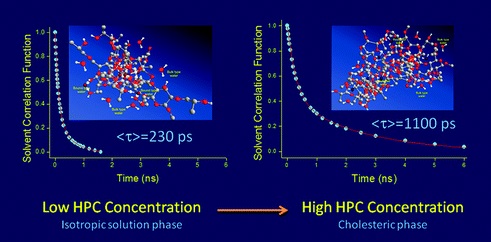- Study the confined or restricted water
Self-organized amphiphilic assemblies (like micelles, reverse micelles, vesicles) provide a fascinating world of bio-mimicking systems. The dynamics of water in the surface of such systems closely relates that of the “biological water”. The nano confinement of water in reverse micelles provides a potential stage for investigation water in the crowded environment in live cells. In these systems the water structure and hydrogen bonding network can be tuned by modifying the composition of the system to simulate various local environment often encountered in biological systems. Our recent studies using ultrafast fluorescence spectroscopy has established the applicability of Arrhenius type of barrier crossing model in the vicinity of micellar and reverse micellar surfaces, which in turn could be extended to real biological environment. The nano droplets of reverse micelles often serve as a template for nanoparticle synthesis and thus the study of the surface film curvature and the associated energy change is very important aspect to study for the size-shape control and optimized growth of the nanomaterials.
Optimization of solubilization capacity of RM is a much anticipated field of research in surface science as high water uptake of RMs is often beneficial for many biophysical applications of RM. It has now been established that increased solubilization capacity involves suitable modification of the mechanical properties of the surfactant monolayer and also of the interaction between the RM droplets. Several previous studies have shown that such an improvement could easily be achieved by blending of surfactants. Mixture of surfactants also brings about desired modification in many applications. However, a proper rationale of the process involved is still not vividly understood. In this regard it was pertinent to investigate whether such a modification in the surfactant interface is reflected in the physical properties as well as dynamics of the entrapped water molecules. |

|
THz region of spctra (1 THz = 1012 Hz= 1 ps-1) is a very important tool to study the nano-materials. Nano-materials (nano-particle, nano-tubes, nano-wire) have attracted attention due to their fascinating opto-electrical properties specially in the high frequency regime due to space confinement of electronic wave function. Decrease of grain dimensions increase the role of surfaces which dramatically alter the complex dielectric and transport properties of nano-materials. THz spectroscopy being a non-contact probe eliminates any chance of errors due to resistive connecting leads. The conductivity of nano-materials are extracted from the composite conductivity using effective medium models (Bruggeman Model or Maxwell-Garnett Model) and are modeled using Drude or Drude-Smith Models and the corresponding scattering times and plasma frequency can be obtained. Coherent phonon modes of spherical small diameter (< 10 nm) nano-particles lie in the THz frequency region. Vibrational modes are extracted from complex dielectric function and modeled using conventional superposition of a number of Lorentz oscillator model. |

|
The THz spctra provides useful information on the collective water network (specially hydrogen bond formation) around different cosolutes, salts and biomolecules, which are otherwise inaccessible by the conventional spectroscopic techniques (conventional MIR or IR spectra gives information on the intramolecular bond vibrations). This cutting age spectroscopic technique has the right energy and the right timescale to probe the dynamics of H-bond diffusion or breaking-making and or partial rotation of water around solutes including biomolecules in solvents. |

|
An understanding of the types of chemical interactions that occur between small molecules and DNA is important for predicting the potential physiological and/or therapeutic consequences of such interactions. There are three general modes of binding that characterize small-molecule interactions with double-stranded DNA: intercalation, groove binding and covalent binding. Different drugs bind to different DNAs and the drugs dissociates from DNA in different conditions. Our main goal is to understand the mechanisms of the Drug-DNA interaction and dissociation processes which are still not clear. |

|
Both intra as well as extra cellular environments are crowded with several macromolecules including proteins, nucleic acids, ribosomes, carbohydrate etc. To mimic this in vivo environment crowded condition can be created experimentally by adding inert synthetic or natural macromolecules termed crowding agents to the systems in vitro. Our interest is to study the structure, hydration, function and thermal stability of different proteins in crowded environment. |

|
Attempts will also be made to develop simulation codes to understand some of the key features regarding on the molecular jump mechanism of water reorientation as well as rotational dynamics of water molecules in anionic and cationic hydration shells. Our primary interest is focused on the understanding the hydrogen bond making and breaking dynamics with water-water network and water-cosolutes network using molecular dynamics (MD) simulation technique. Our major goal would be to establish the trajectory of the orientational correlation functions which is define as, C_n (t)= |
|